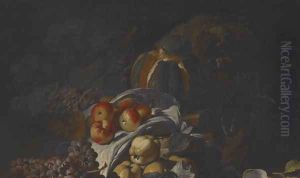Guiseppe Ruoppolo Paintings
Guiseppe Ruoppolo was an Italian painter who was born in 1631 in Naples, Italy, and played a significant role in the Baroque period. He is primarily known for his still-life paintings, a genre that flourished in the 17th century, especially in Southern Europe. Though not as widely recognized as some of his contemporaries, Ruoppolo's work is appreciated for its rich detail, vibrant color, and the skillful arrangement of objects.
Ruoppolo trained under the still-life painter Giovanni Battista Ruoppolo, who was likely a relative, perhaps his uncle. He was part of a circle of Neapolitan still-life painters that included masters like Luca Forte and Giovanni Battista Recco. Ruoppolo's paintings typically feature arrangements of fruit, flowers, and other objects, often with a dark, moody background that helps to highlight the luminosity and textures of the subjects.
During his lifetime, Ruoppolo's work was collected by local patrons and the Neapolitan nobility. His style is characterized by a sense of abundance and the tactile quality of the depicted items, which range from kitchenware to sumptuous fruits and vegetables, and occasionally include dead game, reflecting the Baroque era's fascination with the natural world and its bounties.
Despite being less famous than other Baroque artists, Ruoppolo's influence was felt by his contemporaries and those who followed. His compositions contributed to the development of the still-life genre in Italy and demonstrated the Neapolitan artists' interest in naturalism and the sensory delights of food and flora.
Guiseppe Ruoppolo died in 1710 in Naples, leaving behind a body of work that, while not vast, is noted for its contribution to the still-life genre. His paintings can be found in various art collections and museums, where they continue to be studied and appreciated for their beauty and historical significance.
